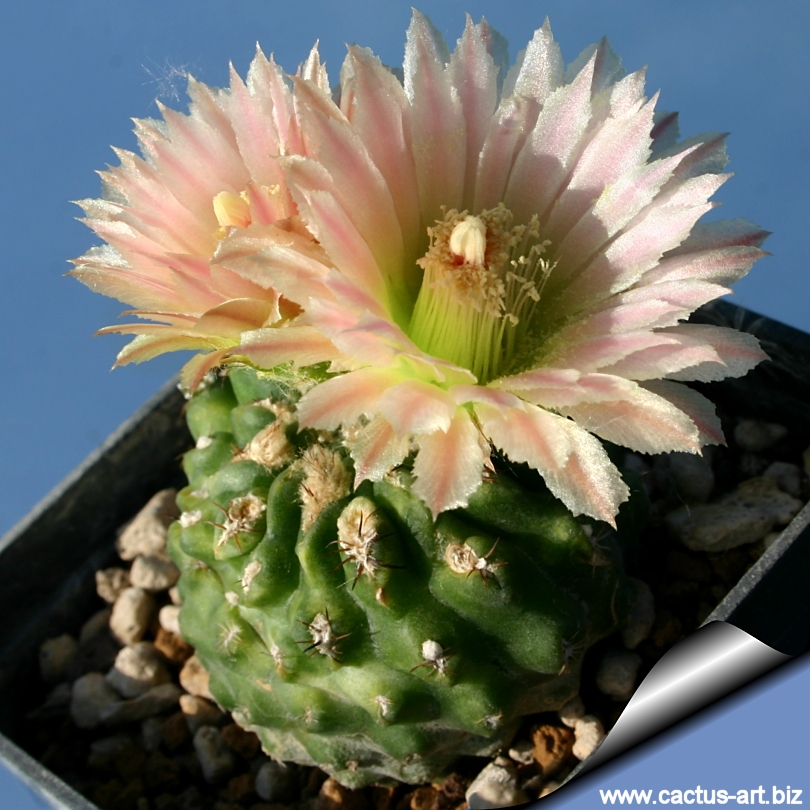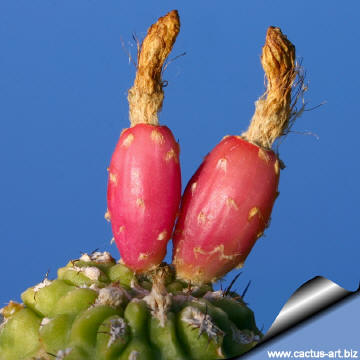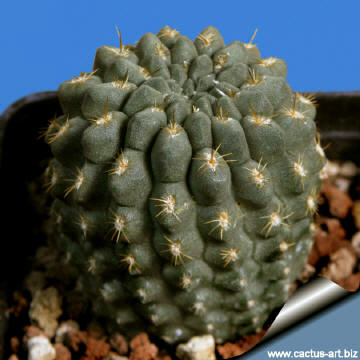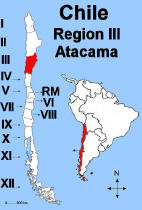|
|
|

Eriosyce napina "viridis" (green form)
|
|
 |
 |
|
. |
 |
 |
|
Propagation: Seeds or graft. Seeds
can be sown in the spring or summer. The seedlings should not be
disturbed until they are well rooted, after which
they can be planted separately in small pots.
|
|


Advertising
|
|
|
|
Family:
Cactaceae (Cactus
Family)
Scientific Name:
Eriosyce
napina
(R. Philippi) F. Kattermann
Published in: Eriosyce (Cactaceae):
The genus revised and amplified 1: 118, 1994
Basionym:
Echinocactus napinus
Phil. 1872
forma "viridis"
Conservation status: Listed in
CITES appendix 2.

Distribution: The
standard species comes from coastal Chile (Region III Atacama) South of
Freirina in the Huasco valley (Atacama
Desert).
The green form "viridis" is (presumably) a
nursery selected form,
sometime found in the trade.
Habitat: E. napina grows in one of the most
arid areas in the world, among rocky crags and sand dunes
in sandy-clayey soil in a
vegetable formation called “Costal desert of Huasco,”
a typical “desertic
mattoral” that is just spectacular and impressive when
it displays the phenomenon
of the
“flowering desert”.
Altitude around 200 m.
Etymology:
The
genus
name
"Eriosyce"
derives from the Greek words “Erion (εριον)”
meaning “wool” and “Sykos” meaning “fig (a
fruit)” .
(The genus name implies: “woolly
fruits”).
The
species name
“napina”
derives from the
Latin
“napus” meaning
"turnip”
plus the adjective suffix for nouns "inus" meaning
"belonging to or resembling"
(The specific name implies: “resembling
a turnip”)
Synonyms:
- Neoporteria napina, (Philippi)
Backeberg 1935
Published
in: Blatter Kakteenforsch., Pt. 9, [p. 4], 1935
- Neochilenia napina (Phil.) Backeb.
1942
- Thelocephala napina (Phil.) Y.Itô
1957
- Chileorebutia napina (Phil.)
F.Ritter (Nom inval.) 1959
- Chilenia napina (Phil.) Backeb.
1939
- Echinocactus mitis Phil. 1894
- Neochilenia mitis (Phil.) Backeb.
1959
- Neochilenia imitans Backeb. (Nom.
inval.) 1959
- Neochilenia neoreichei Backeb.
(Nom. inval.) 1959
- Reicheocactus neoreichei (Backeb.)
Backeb. (Nom. inval.) 1962
- Echinocactus napinus Phil. 1872
miniature
|
|
|
|
Description:
Tiny
geophyte, with a
solitary
spherical or flattened stem slowly growing atop a thick, underground
taproot, with a
constriction between the stem and the root. eventually becoming
somewhat
elongated in cultivation.
The forma "viridis" is very similar to the standard
species only differs for the stem colour which is a bright grass green
and not a dark tannish-brown.
Stem:
Slow growing, up to 3-5
cm across, 2-6 cm tall, green, but more
commonly with brown-olive-grey tones.
Tubercles : Larger than ssp. lembckei;
Areoles:
Grey.
Spines: Very short black
radials.
Roots: Forms a
tuberous root system with (usually) a very large
carrot-like root
Flower: Approx 3,5 cm long, 4-6 cm
in diameter, whitish,
yellowish, pinkish to pale brick-red with a silky shine,
buds densely
hairy with brown
wool.
Fruit: Large,
red,
clavate, wrapped in white
wool.
Phenology: Flowers already when young,
synchronised flowering of the whole plants takes place over one or
two days, and they remain open for about three or four days.
Blossoming time: late spring.
|
|
Cultivation: The eriosyces have a thick
taproot and are
susceptible to
over-watering.
Sometimes they are
grafted to avoid
root rot problems. Suited for
sunny-bright exposure; they
can tolerate
light shade. They like
warmth (recommended minimum winter temperature 5° C).
But plant kept perfectly dry can easily
survive in winter
night temperatures below 0° C (In our greenhouse there was no damage at
-10° C for a few hours in the winter of 2002-2003 )
They prefer
airy exposures. They also need a deep pot and good
drainage, to accommodate its
tap root. Keep dry in
winter.
Pests &
diseases: E. napina is especially
prone to rot, therefore,
underpot in a smaller container filled with a
very
porous compost.
Photo of conspecific taxa, varieties, forms and cultivars of
E. napina. (This
Taxon has lots of synonyms,
with several controversial varieties and
subspecies, and comprises a multitude of
different forms)
|
|